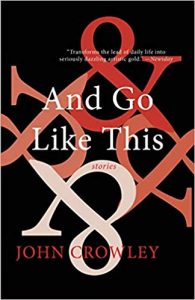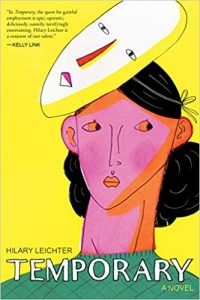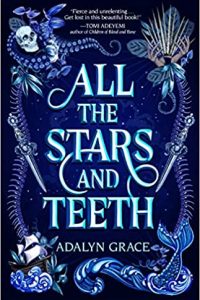Gary K. Wolfe Reviews And Go Like This by John Crowley
 And Go Like This, John Crowley (Small Beer 978-1-6187-3163-0, $25.00, 332pp, hc) November 2019.
And Go Like This, John Crowley (Small Beer 978-1-6187-3163-0, $25.00, 332pp, hc) November 2019.
One of John Crowley’s most beautiful novellas, “The Girlhood of Shakespeare’s Heroines”, originally appeared in the now-famous, Peter Straub-edited issue of the literary journal Conjunctions in 2002, the first issue to prominently feature SF, fantasy, and horror writers. Crowley’s novella was the lead story, and now it’s quite properly the lead in And Go Like This, his first major collection of short fiction in 15 years. Set partly in the early 1950s and partly in 1980, it tells of two young friends who meet at an unlikely Indiana Shakespeare festival, become lovers, are both stricken with polio, and later face post-polio syndrome as they finally consider marriage. There’s not a word of material SF or fantasy in it, and yet the story somehow evokes the quest for secret histories of his Aegypt series in the degree to which both main characters, inspired by an obsessive director at that long-ago Shakespeare festival, become intrigued by the Baconian heresy, and in particular the crypto-scholarly work of a real-life 19th-century author named Delia Bacon, as well as related work (the title comes from another 19th-century book, by Mary Cowden Clarke, speculating on exactly what that title says). So although this undeniably brilliant piece isn’t itself speculative, it’s largely about speculation and dreams of hidden tales. Along with novels like The Translator and Four Freedoms, it’s a good example of Crowley’s often oblique relationship with the genres in which he began his career: some of his work feels like fantasy when it isn’t fantasy at all.
Another essentially mainstream story, “This Is Our Town”, is a luminous first-person account of a devout Catholic childhood in a small town, possibly in Pennsylvania – except, as we are told at the outset, the town only exists in a 1953 Catholic children’s book called This Is Our Town (an actual book). Has the narrator somehow escaped from this book to tell us his tale? Is the implied presence of guardian angels real in this world, or simply a metaphor of childlike faith? Either way, the sense of the numinous gives the story an undertone of things invisible to see. A suite of three related stories collectively titled “Mount Auburn Street” deals with the challenges of aging: Harry, the 60-year-old author of a popular rhetoric book enters a Cognitive Rehabilitation Program after realizing he can no longer remember his dreams, and later comically grapples with a buggy early version of Dragon speech-recognition software as he tries to reconstruct the manuscript of his book, lost in a house fire that may in part have been his fault. His friend Stan, a real estate broker, finds himself experiencing an unexpected sexual renewal, and decides to try Viagra after it fizzles out. These stories are more straightforwardly set in a familiar Cheever-like community, pretty much without that numinous undertone.
None of this should suggest that Crowley has abandoned his capacity for fantasy and absurdity. The title story, “And Go Like This”, literalizes a speculation by Buckminster Fuller that the entire world population in 1963 could fit into New York City and still have room to twist (the title actually comes from that old Chubby Checker song). It’s mostly silly fun. “Conversation Hearts” alternates the very mundane tale of a family waiting for their author mother to make it home in a dangerous snowstorm with chapters from the mother’s fantastical children’s book, set on a planet whose characters bear Calvino-like, all-consonant names and are born with fur. The outsider status of a child born without fur, we realize, echoes the experience of a disabled daughter of the family, making the whole story a rather tender exploration of the challenges of being different. “In the Tom Mix Museum” seems a simple one-page memoir, except that this museum (unlike the real one) is a gigantic figure of the cowboy star himself, entered through the boot heel and with a daunting climb to the top.) “The Million Monkeys of M. Borel” is a Borges-like meditation on the famous thought-experiment of all those typing monkeys, first proposed by Borel, and how it might be altered by a predictive (but still pretty pointless) computer program.
The stories which are likely to be of greatest interest to followers of Crowley’s fantasy and SF include “Flint and Mirror”, which richly evokes the parahistorical world of his Aegypt series, presented as a newly discovered manuscript fragment of the writer Fellowes Kraft from those novels. It traces the youth of Hugh O’Neill, who becomes a lord in the Tudor-era struggle between England and Ireland, and who is given a magical obsidian mirror by the famous alchemist Dr. John Dee, which seems to represent an unknown power to alter history. Probably the closest thing we’ll see to a Crowley horror story is the Edgar-winning “Spring Break”, set in a grim future in which higher education is so entirely online that physical campuses are obsolete. But the spring break tradition continues, and the narrator decides to use his to explore an actual university in New Haven (obviously Yale), where he meets a lonely but creepy librarian and is astonished at the spectacle of so many individual physical books. The librarian has a surprise for him right out of Poe (the best our unliterary narrator can come up with by way of protest is “For the love of Mike!”), but the strength of the tale comes less from its facile set-up and ending than from the narrator’s astonishment at learning what information used to mean.
The one new story, “Anosognosia”, is also one of the best, echoing Crowley classics like “Snow” in its evocation of the choices our lives are made of. Following an accidental head injury in 1959, a high school junior named John finds himself experiencing a kind of newfound wonder at the world around him, “returned, estranged, but with gifts and weapons he hadn’t had before.” He insists on transferring from his Catholic school toa more distant public school, financing the need for a car by selling a Twilight Zone-like story (with a sort of Sliding Doors plot) to a pop magazine and a TV show. He eventually grows up to be a successful middle-aged screenwriter – whom we meet through a series of interpolated transcripts of therapy sessions, in which he insists he has also led a life in which he became a novelist in New England, and can even recite at length the plots of novels he had written. The therapist suggests that John’s inability to recognize this as a delusion is evidence of a condition called anosognosia, and it turns out that John had produced a short film with exactly that title. Is John’s alternate life an actual parallel reality, in which (among other things) Kennedy was never assassinated, or a neurological anomaly? Or perhaps, as hinted at briefly, is his career as a film and theater student and later filmmaker and screenwriter simply one of the novels written by the New England version of himself? And can he actually decide which life to choose before his upcoming 50th birthday, which he seems to regard as something of a Jonbar point? Given the themes of aging and memory that run throughout the collection, it’s tempting to read this as a personal, even autobiographical, meditation (the character’s name is John C., he’s about Crowley’s age, his family moved from Kentucky to Indiana during his high school years – as Crowley’s did – and like Crowley he initially set out to make movies), but that’s hardly necessary to appreciate this haunting and gorgeously written exploration of memory and choice. It’s worth the price of the book, but then so is “The Girlhood of Shakespeare’s Heroines”. Sometime in the past, Crowley made the right choice.
Gary K. Wolfe is Emeritus Professor of Humanities at Roosevelt University and a reviewer for Locus magazine since 1991. His reviews have been collected in Soundings (BSFA Award 2006; Hugo nominee), Bearings (Hugo nominee 2011), and Sightings (2011), and his Evaporating Genres: Essays on Fantastic Literature (Wesleyan) received the Locus Award in 2012. Earlier books include The Known and the Unknown: The Iconography of Science Fiction (Eaton Award, 1981), Harlan Ellison: The Edge of Forever (with Ellen Weil, 2002), and David Lindsay (1982). For the Library of America, he edited American Science Fiction: Nine Classic Novels of the 1950s in 2012, with a similar set for the 1960s forthcoming. He has received the Pilgrim Award from the Science Fiction Research Association, the Distinguished Scholarship Award from the International Association for the Fantastic in the Arts, and a Special World Fantasy Award for criticism. His 24-lecture series How Great Science Fiction Works appeared from The Great Courses in 2016. He has received six Hugo nominations, two for his reviews collections and four for The Coode Street Podcast, which he has co-hosted with Jonathan Strahan for more than 300 episodes. He lives in Chicago.
This review and more like it in the October 2019 issue of Locus.
 While you are here, please take a moment to support Locus with a one-time or recurring donation. We rely on reader donations to keep the magazine and site going, and would like to keep the site paywall free, but WE NEED YOUR FINANCIAL SUPPORT to continue quality coverage of the science fiction and fantasy field.
While you are here, please take a moment to support Locus with a one-time or recurring donation. We rely on reader donations to keep the magazine and site going, and would like to keep the site paywall free, but WE NEED YOUR FINANCIAL SUPPORT to continue quality coverage of the science fiction and fantasy field.





